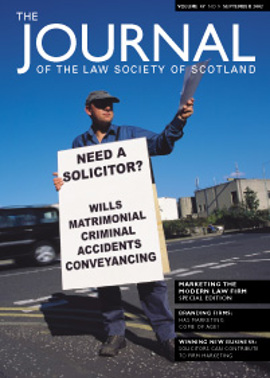Book reviews
Licensing (Scotland) Act 1976 (5th Edition)
By Sir Crispin Agnew and HM Baillie. W Green. Price £48. ISBN 0414 01488 X
The publicity blurb on the back cover of the book promises the purchaser that it is “fully revised and updated” and “is an excellent portable companion”. However, on a rather sad note for the practitioner, I noted from the introduction that the publishers have decided that this is to be the final edition of the book.
It is fully revised and updated and the editors are to be congratulated for packing in a considerable amount of material to a relatively slim volume. It is not simply a matter of tweaking the Fourth Edition by adding some new case law, but there is additional material in the book. For example, there is now a new Table of Statutes and Statutory Instruments fully indexed and cross-referenced. It may be a sign of the times but I noted the first mention of European legislation in the Table of Statutes in the shape of a 1976 Directive!
One of the hidden treasures of the book is the considerable wealth of detail in the General Introduction which runs to 46 pages. This is no mere historical padding as this wealth of detail is more akin to a mini treatise on the development of licensing law in Scotland. The editors have not just confined themselves, in the General Introduction, to updating references to new case law but have produced brand new sections on the effect of e-commerce and the Human Rights Act 1998 on licensing law. This ought to be compulsory reading as I suspect the whole issue of “proportionality” will keep litigation practitioners busily occupied for some time to come. As befits the ever-growing corpus which is Judicial Review, the editors have expanded its treatment in the General Introduction with new material and updated case law.
As for the text dealing with the 1976 Act, each section has its general note of explanation and if the section is complicated and merits it then each sub-section is broken down to explanation and reference to the appropriate case law brought up to date including unreported case law. Such is the rapid growth in this area of the law that the commentary on Section 17 of the Act (Grounds of Refusal of Application) now runs to no less than five pages of commentary. However, that is pipped to the post by the venerable Section 39 (Appeals to the Sheriff) which runs to just over five pages of closely written commentary!
If I were to have a niggle with the way that the material is set out, it would be that the Law Reform (Miscellaneous Provisions (Scotland)) Act 1990, which principally deals with regular extensions and children’s certificates, has been separated out from the body of the 1976 Act text albeit that most of the sections of the 1990 Act are incorporated back into the 1976 Act. However, there is a trap for the unwary. Sections 46, 47, 49 and 50 dealing with permitted hours and children’s certificates were new law and not additions to the 1976 Act and therefore the reader has to be alive to this and appreciate that if one is looking for guidance and indeed commentary on these matters then one must turn to the end of the text rather than the 1976 Act material for help.
However, this is a small matter indeed. The volume does live up to its description as being “an excellent portable companion” because of its wealth of detail and erudition. Reference to all of the case law makes it not only a purchase which is value for money but a necessary one for those who have a serious interest in the subject matter and wish to maintain an appropriate level of knowledge.
In this issue
- Marketing through the ages
- Making the most of marketing
- Firms embrace merits of marketing
- Marketing methods for smaller firms
- Investing in people brings rewards
- Time to learn from enlightened English courts?
- Distinction between threatened and completed wrong
- Make it policy to know about policy cover
- In practice
- Plain speaking
- Book reviews






